We have had lots of questions coming in about raising rabbits for meat and how we handle rabbit care here on our little backyard farm. So we thought we would take you through a little run down of what we have found works and doesn’t work for us.
Right now we have three breeders, Buck Rogers III- our buck:
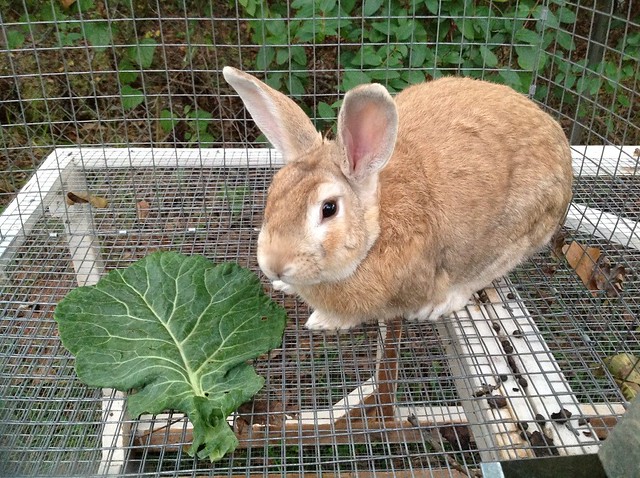
Digger-our now somewhat experienced momma: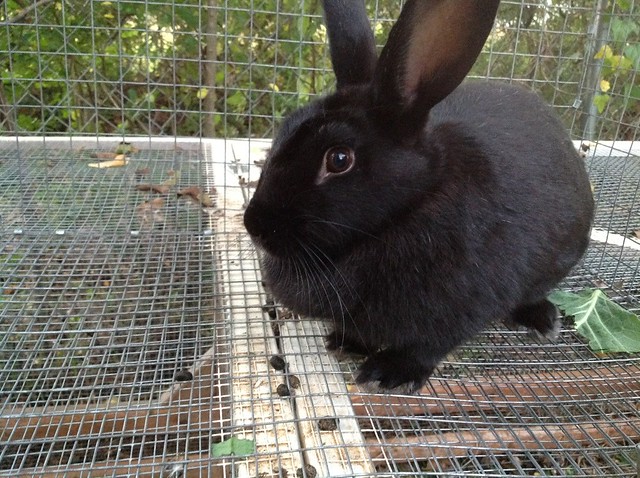
Remi (short for Redeemed….how is that short for it? I don’t know)- our new breeder from Buck and Digger’s first litter:
Remi got spared from the butcher line at the last minute when it turned out her much prettier silver “sister” was actually a male. Hence her name haha. She is old enough to be bred but we are holding off on breeding all the girls again until fall due to the heat.
And Snow….our third and last breeder for now.
Here are the rabbits “tractors” that have been de-tractorified.
Buck Rogers:
We have them raised up on cinder blocks:
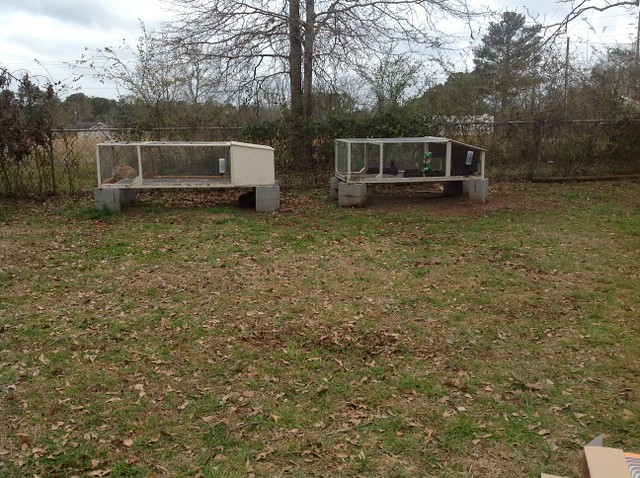
Eventually we will have another smaller pen for Buck and the breeders will each have their own tractors most likely.
Our Experience Raising Rabbits in Tractors:
When we started raising the rabbits a little over a year ago we had high hopes of being able to graze them in rabbit “tractors” in our backyard. Our yard is about 1/2 an acre where we could move them around so we were just certain it would work. Turned out it was quite a pain and not very successful. Rabbits are natural diggers (hence Digger’s name) and we never quite got in enough of a groove to make it work for us.
We are renters so we are very aware of the fact that we want our work on the house and yard to be improving the property and not tearing it down. Had this been our property and we REALLY wanted to have the rabbits graze we would have ripped up the current grass and reseeded with a pasture grass or a pasture/clover mixture. The current grass that is planted is just not a fast enough growing variety to keep up with the needs of a confined rabbit. Even with our continual efforts of reseeding the areas the rabbits had been in we were not happy with the condition of our yard when we were grazing them.
They also need to be moved everyday or twice a day to keep up with their grass needs and to discourage digging. This proved to be a challenge to keep up with in our busy schedule and they often did not get moved frequently enough. At first we had a complete open bottom with wire only on the outside 4 inches of edge, they almost dug out several times with this setup. We then tried a large fencing wire trying to keep them in but not limit their grass consumption. They still dug quite large holes with this, though they now couldn’t escape.
This setup also proved to make it much more difficult to harvest their manure which we desperately need to improve our garden beds.
We live in the south so summers here are a big problem with rabbits, as they do not like hot temperatures. We found that as we moved them through the yard it was inevitable even with our very well shaded backyard that some part of their pen was in direct sunlight during the course of the day. After losing two rabbits to heat stroke combined with the other problems, we went back to the drawing board.
Ultimately we decided that we still loved their tractor homes but that they needed to be raised up for ease of maintenance and their health at this point. In the future if we have a large pasture this may change but for the backyard rabbit flock we believe that the cons outweigh the benefits.
Rabbit Tractor Design:
We love the design of our tractors! They are lightweight but still very sturdy and we think they look really nice in our yard.
After building two and living with them for a year here are a few things we would modify on the next ones:
Flooring:
The contractor fabric works great in Buck’s pen and allows the poop pellets to drop right through. But in the females pen it is just a little too small, so there becomes quite a bit of build up that has to be scraped out and then washed down with a hose with a sprayer on it. Not the end of the world but if you can go with a little larger mesh at least for the exterior strip it would save you some effort each week.
After housing the three breeders and a full sized litter of kits the flooring started really struggling. We will be replacing the flooring with a heavier gauge rabbit wire that is intended for suspended cages.
Nesting boxes:
The nesting boxes should be made of wire on the bottom not wood. The babies do not seem to realize that soiling their bed is gross and continue this even into their semi-adult lives. It would be best for this area to be mesh all the way across with a wooden nest box added in if it is cold out and removed once they are moving around.
Feeders:
With the nesting box area removed and wire there it would be simple to add a longer feeder down the length of the back of the pen. Two of the little metal feeders are inadequate for this many rabbits and in the pushing and shoving to get to food they inevitably spill feed and/or knock over the feeders even with the various manners of attaching them to the walls or wire we have tried. Something that is expandable as they grow that actually slides down into a groove or secures more firmly to the back of the cage is what we are going to try next.
Waterers:
We HATED the dinky little water bottles that the feed store sold us. With 10 rabbits in a pen we refilled them constantly and they never seemed satisfied. We just created this new 5 gallon rabbit watering system and absolutely love it!
It seems to be working adequately with a single nozzle but we may end up adding a few more if they start crowding it.
Rabbit Colony:
Something that we are currently reading and experimenting with is a raising rabbits in a colony.
This is a nice example of a colony setup (not ours) to give you an idea of a “traditional colony setup”:
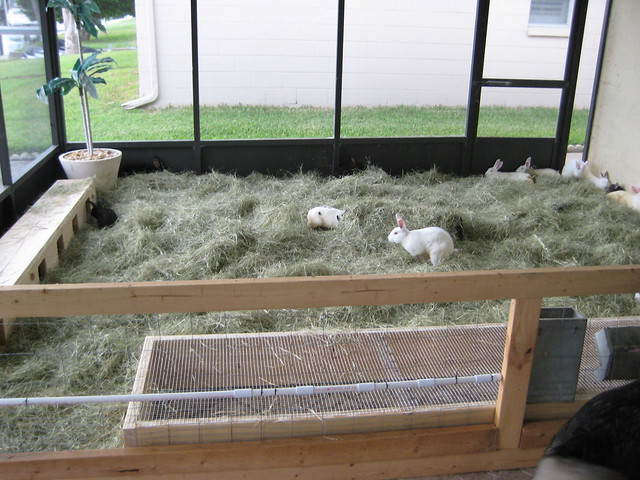
Photo credit to PrepRunner.
We are really more of a modified colony setup honestly since the rabbits are in suspended tractors. But we have done this for a few reasons. The first reason is that it provides a much more natural environment socially for the animals. We love this as they hop all over and really have a fun time chasing each other and lounging around. You can definitely tell that they enjoy their lives with more space.
It also greatly decreases the cost and time investment needed to take care of large amounts of animals. We have found this to be very true and love that we are having some success so far in this area. We also have 3 generations in one pen right now and have been doing this for several months without troubles which makes taking care of them a lot less time consuming and we didn’t have to buy 20 cages plus waterers and feeders for each one.
The two primary potential problems with colony raising are:
1) Rabbits can be very territorial and a bad fight can leave you with dead rabbits on your hands. And
2) Some people have also reported problems with diseases spreading through a colony rapidly when housed on the ground.
Our solution has been to raise them from birth together (or mother/daughters) so they never have to go through that territorial process and to suspended large pens instead of raising them directly on the ground.
When we had Digger and Lady together in their pen they did just fine together until we separated them. Once we tried to move them back together, they had quite a nasty fight. With the tractors being relatively small in terms of colony setups we decided not to let them try to work it out.
Digger, Remi, Snow and Digger’s newest litter shared quarters without any problems including during the kindling period all the way through to the litters butchering date.
It is possible to have multiple litters from different mothers in the same pen but we probably will not actually attempt this simply based on the quantity of rabbits and strain on the wire.
Feeding Rabbits:
We have been feeding the rabbits a pelleted complete rabbit feed we get from our feed store. They were grazing last summer but since they have been moved off pasture we have tried to supplement them with greens from the garden and our green compost scraps (sparingly). They love this and we have had no problems with upset tummy or diarrhea even in the young babies.
We would eventually like to grow much of their food and there is lots of info out there on sprouting fodder as well as gathering native plants for them to eat. At this point the time commitment for both of those is prohibitive to our needs but it certainly can be done.
Heat Management:
Rabbits don’t like heat and they really don’t like humid heat. Which means living in Georgia is not the most conducive place for a rabbit who can’t dig a hole to escape.
We provided Digger with a frozen 2 liter soda bottle of water everyday during the heat to lie next to, which is quite possibly the only reason she made it through the summer. When they have this their water consumption in the bottles goes down drastically as they lick off the condensation on the bottles.
But plenty of fresh water is absolutely necessary in the summer months. We will be experimenting with whether adding ice to their five gallon bucket waterer to cool the water further helps them or if it is a waste of time and energy.
Shade is another absolute must, they MUST be able to get out of the sun at all times. We will be stretching tarps over the tops of the pens (but not the sides to keep airflow maximized) once things start heating up around here to provide them even more shade.
Fans, misting systems and AC are all options that people utilize to help manage the heat. We are looking into some solar fans as a sustainable option for this area as we really hate using electricity for more things than are absolutely necessary.
Butchering
We process our rabbits between 12-14 weeks on average. We use the broomstick method for dispatching them. *Feel free to google if you need a tutorial on this*
Thanks for reading and feel free to ask any questions you may have!
Note: we do not approve rude or negative comments towards the humane raising of rabbits for meat. We respect those who believe in not eating meat and appreciate the same respect. Please refer to our post here for more thoughts on why we raise animals for meat for our family.
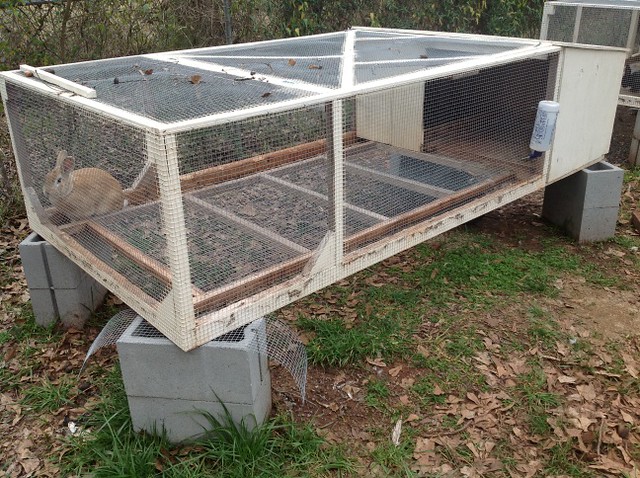
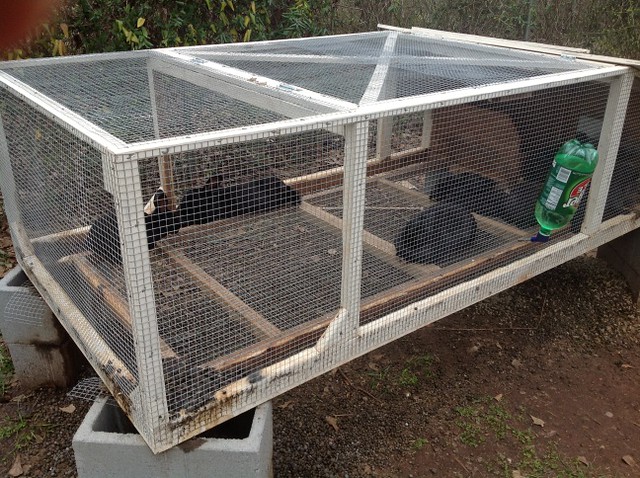
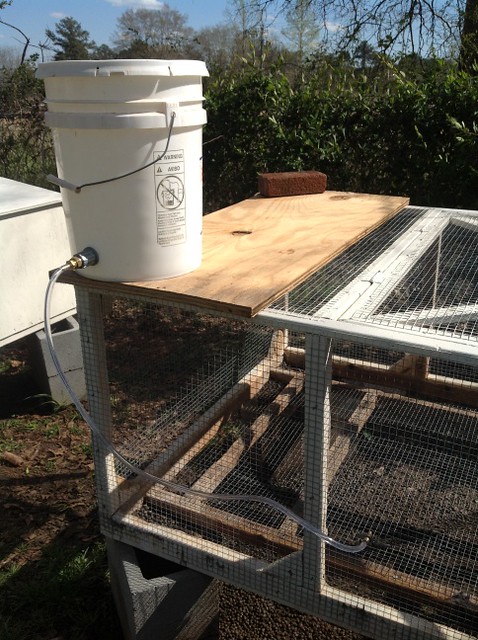

Do you worry about inbreeding? Or do you butcher the babies before they can do that? And does your buck stay with all the ladies?
We kept the buck separated from the ladies and yes did not breed daughters back to the same buck and mostly culled them. We had several dedicated breeder mamas and two bucks so it was pretty easy to manage. If you were wanting to keep a good chunk of the first litters I would likely just take the mamas to a farm to spend time with a buck and then purchase a farm buck that was not related.
I really want to do this when I move out of my mom’s house. She knows I’m interested in it but I’m not gonna do it around her. She’s a sensitive soul and doesn’t like to think about such things.
Thank you !
Very informative. I am trying to convince my girls to raise meat rabbits but the thought makes them too sad.
Candis from Alberta, Canada